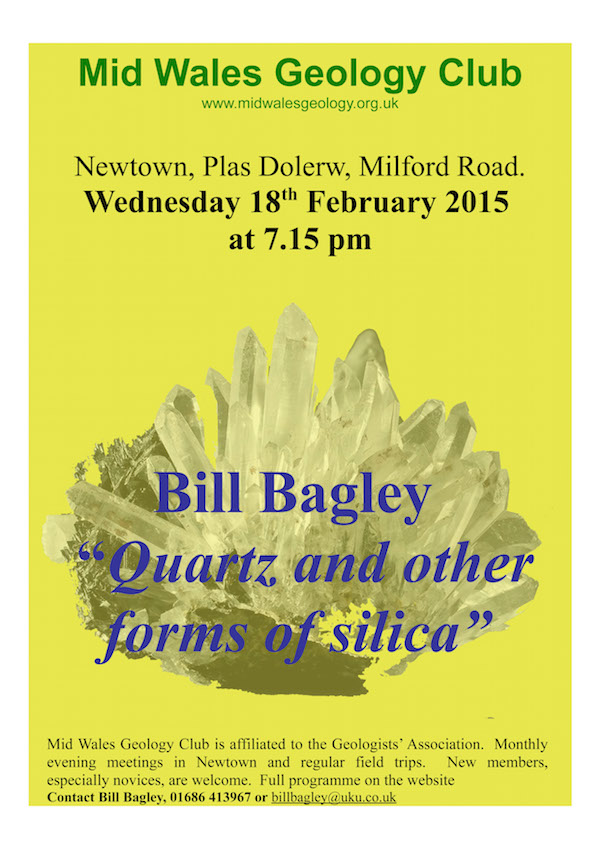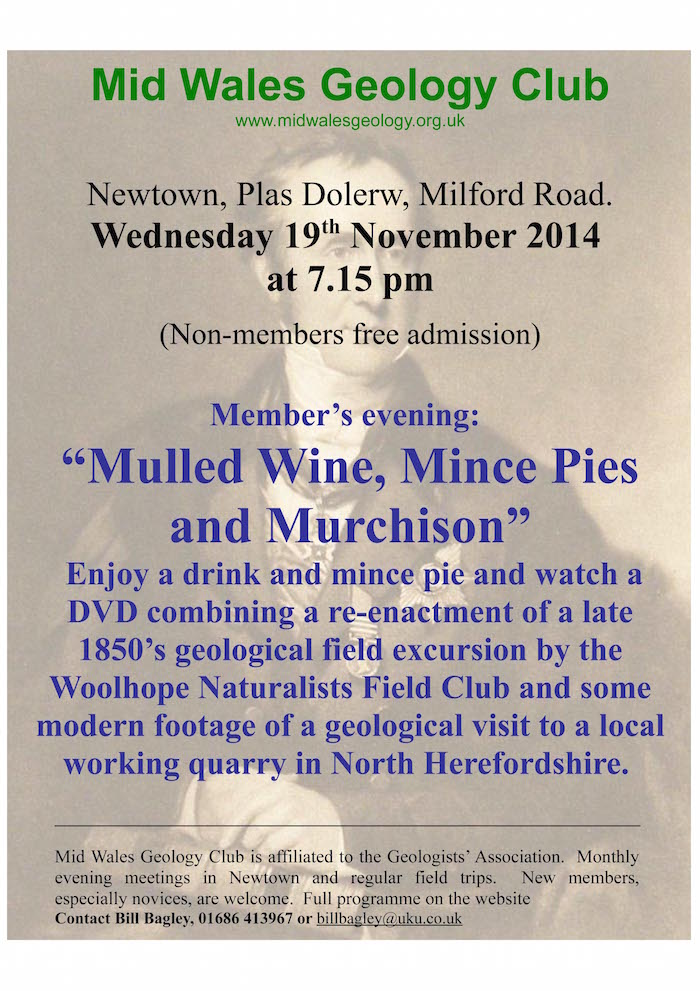Monday 23rd February 2015
Bill gave a really interesting talk on quartz and other forms of silica. The talk commenced with
a general description of the elements that go to make up the earth's crust. Bill then delved more
deeply into the chemical structure of silica and polymorphism and then into the different branches
of the quartz family. This consists of, firstly, basic quartz types, for example Rock crystal, Rose
Quartz and Citrine. Then there is amorphous quartz, including Opal and Obsidian. The Chalcedony
branch includes Chrysophrase, Onyx, Heliotrope and the Agates. Most of these are fairly well
known, but what are not quite so well known are some of the quartz/silica polymorphs. These are
varieties that have been altered by heat or pressure or by both heat and pressure. These include
minerals such as Keatite and Coesite. Silica also is present in many rock types, eg. Granite. These
groups were then looked at in much more detail, accompanied by photographs of each mineral.
Finally, the role of silica in technology was discussed from the use in quartz time-pieces to modern
uses in nanotechnology.
Alongside the talk Bill brought along a large number of superb specimens for all to view.
The next talk will be on Wednesday 18th March, when guest speaker Kevin Voyce (Environment Agency) will give a talk entitled: “Strategic Ground Water Management”
Tuesday 10th February 2015
Our next event will be on the 18th of February at 7:15 with Bill Bagley's talk "Quartz and other forms of silica"

Wednesday 4th February 2015
The AGM was held on 21st January, a cold evening with frequent snow flurries. The AGM was followed by one of Dr. Geoff Steel's very interesting talks. On this occasion his talk was entitled, “The Tyrone Ophiolite: ancient ocean floor on land in Northern Ireland”.
Geoff commenced the talk with an explanation of ophiolites in general. They are interpreted as fragments of ocean floor that have been sheared off from subducting crust, caught between colliding continents and then elevated to a continental location. A typical ophiolite suite can be defined as consisting of the following (from base up): unlayered serpentinised peridotite, layered gabbro, massive gabbro, sheeted dyke complex, pillow basalts, deep sea sediments. Although not all ophiolites contain all the layers. Ophiolites are important as they allow access to oceanic crust and upper mantle that otherwise would be unobtainable. The age of oceanic crust is dated to about 200my. Therefore, an ophiolite that is dated as much older allows study and understanding of much earlier events and provides evidence for the existence of old oceans and oceanic basins. The Tyrone ophiolite was obducted onto the continental margin of Laurentia during closure of the Iapetus Ocean during the Ordovician Period.
It was Geoff's intention to observe as many elements of the ophiolite as possible. On his tour he visited Beltonanean Mountain and Black Rock where he observed the gabbro. The gabbro here consisted of coarse to very coarse-grained varieties. The gabbros at Black rock are also cut by younger balsaltic and doleritic intrusions which are in the form of 1 to 2m wide dykes. These sheeted-dykes are also part of the ophiolite. They were also viewed at Carrickmore where they cut through Hornblende gabbro. Originally these dykes would have acted as feeders for the overlying sequence of pillow lavas. The latter were viewed at Creggan rock. The final location on the tour was the Carraghinault gold mine. This gold was formed as part of the orogenic phase of the closure of the Iapetus Ocean. As this is a working quarry it could only be viewed from a distance.
The talk ended with some of the members now thinking of a visit to Ireland!
The next meeting will be on Wednesday 18th February. Club Secretary, Bill Bagley will be giving a talk entitled: “Quartz and Other Forms of Silica.”
Thursday 18th December 2014
23 members attended and had an enjoyable evening at the November meeting. Members were entertained by a DVD ( Picnic in Siluria) produced by the geological section of the Woolhope Naturalists Field Club. The film was a re-enactment of an 1850’s field visit by Sir Roderick Murchison to a site near Aymestrey in Herefordshire. The scene was set by a short talk given by Robert Williams who was part of the re-enactment in the guise of Sir Charles Lyell.
The next indoor meeting will be held on Wednesday 21st January.This will be the AGM followed by a talk by Dr Geoff Steel entitled: “ The Tyrone Ophiolite; ancient ocean floor on land in Northern Ireland.”
Tuesday 28th October 2014
The next event will be a member's social evening on the 19th of November.


